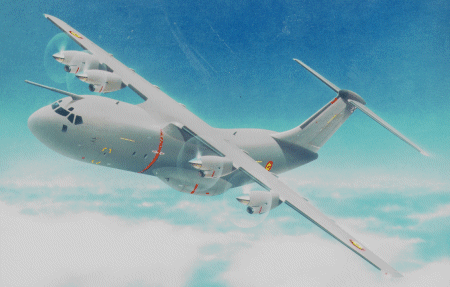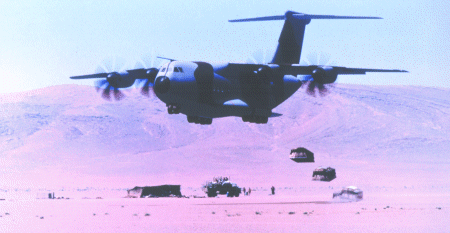Julian Moxon/PARIS

When the response to the formal request for proposals for the Future Large Aircraft (FLA) military transport was delivered to Belgium, France, Germany, Italy, Spain, Turkey and the UK on 29 January, there was an almost audible sigh of relief at the Airbus Military Company (AMC) programme office in Toulouse.
After years of attempts to win credibility, the aircraft, previously also known as the FLA, but now renamed the A400M, had become an Airbus Industrie programme. "It's not an orphan child any more," says A400M marketing chief David Jennings:
The 24-volume document sent to the seven ministries of defence spells out the commercial and technical details of a bid to meet the European Staff Requirement (ESR) for a transport aircraft to replace at least 400 in-service Lockheed Martin C-130s and Transalls, which have an average age of 24 years.
Typically for Europe, however, the story is not quite as straightforward. Under the Future Transport Aircraft (FTA) programme, Belgium, France, Spain and the UK have also asked for bids from AMC, Russia/Ukraine and the USA, to flush out the potential for competitive proposals from Lockheed Martin, proposing the C-130J (purchased as an interim solution by the UK), Boeing, for the C-17 Globemaster III, and Russia, with the An-7X (the An-70, modified to meet the ESR).
France, Germany, Italy and Spain have meanwhile asked for separate proposals on the An-70. The aim here is essentially to see how closely the aircraft fits the ESR. A recent study by DaimlerChrysler Aerospace (Dasa) concludes that the An-70 meets several ESR requirements, but finds that a considerable amount of work would be necessary in key areas (Flight International, 9-15 June).
The finding highlights the continuing split between the German Government and Dasa on how best to meet the ESR. Dasa - a major Airbus partner - favours pursuing the A400M, while the government, for political reasons, is pushing for an An-70-based solution and has formed the Airtruck consortium to look into ways of Westernising the Ukrainian aircraft.
Richard Thompson, A400M commercial director at AMC, says: "We're working to get the German Government on board, but, if they back down, we will have to look at who remains and establish whether we have a business case."
A decision is due at the end of the year. If the A400M wins, the programme would be launched officially next year, with a first flight in 2004 and delivery two years later. The decision could be complicated, however, if the FTA countries opt for interim solutions.
The economics of the A400M programme are based on a production run of 288 aircraft (Germany 75 , France 50, the UK 45, Italy 44, Spain 36, Turkey 26, Belgium 12). Thompson admits: "We really don't know what the nations are thinking in terms of numbers, but they have to make commercial sense. If you have fewer aircraft, there is obviously a less attractive business case. The crunch comes when you have to prepare a budget against the real operational requirements and industrial agendas."
Thompson adds, however, that the need to respond to the request for proposals (RFP) has clarified the programme. He pushes the "clear case" for a brand-new aircraft incorporating proven Airbus technology, saying that it will have "twice the volume [of the C-130J], twice the payload and almost identical life cycle costs". Compared to the C-17, the A400M provides "two-thirds of the volume and half the mean payload, but at less than half of the price and one-third of the life-cycle cost", he adds.
The ESR was issued in September 1996, and was followed by the RFP a year later. It is NATO-restricted and its exact contents are unavailable. What is clear is that it is the most comprehensive specification produced for a European military transport. In essence, it calls for industry to come up with a four-engined turboprop, built to civil design standards, using modern technology. It should provide "rapid, reliable air mobility for force deployment and humanitarian missions, airdrop and air-to-air refuelling capability, major life-cycle cost savings and delivery availability to 2015".

Designed to fit
AMC says the fact that the A400M is designed to reflect exactly the ESR is one of the main planks of its case for the aircraft. The programme is being run under strictly commercial lines in which industry will respond to the RFP with a fixed-price proposal, guaranteed performances, a frozen specification and guaranteed delivery dates. Once production is launched, stiff penalties will apply for nations that pull out.
Following what Jennings describes as a "somewhat tortuous" process, workshares for the aircraft have been decided. The rationale was to apportion the work in a reasonable approximation to each nation's planned offtake, and in accordance with existing core specialities developed through involvement in the Airbus civil aircraft consortium. So, France's Aerospatiale Matra, for example, retains its expertise on the cockpit and nose, British Aerospace on the wing (but only after a protracted battle with Germany), Spain's CASA on the horizontal stabiliser and Germany's Dasa on the centre fuselage and vertical tailplane. Spain has also won the final assembly prize and will build the aircraft at its Seville plant.
Non-Airbus consortium members Alenia (Italy), Flabel (Belgium) and Turkish Aerospace Industries (TAI) were also given stakes according to their industrial capabilities, with Alenia responsible for the aft fuselage, moving surfaces (with British Aerospace and Flabel) and the cargo handling system. Flabel, a major supplier of Airbus wing-associated equipment, is a member of the wing team, along with BAe and Dasa. TAI, involved in a major Airbus programme for the first time, will be responsible for the forward centre fuselage and doors. It will also collaborate on other items, including the nose section.
The A400M draws heavily on Airbus practice in applying the ESR requirement for the "best application of existing technology". The Airbus Concurrent Engineering system is being used to define the aircraft, providing a single digital mock-up available to all partners as a unique source for everything, including stress, maintenance, accessibility and even marketing.
Elements of the A400M design have entered testing, with the initial design of the wing, for example, approaching completion following high-speed windtunnel tests in France and low-speed tests in Germany. A400M chief engineer Jean-Jacques Cuny says: "The wing is the longest lead time item and, in the case of the A400M, the design is demanding because it has to meet stringent low and high speed requirements to cater for the multirole mission profile."
Work also centres on what Cuny calls the "very real problem" of integrating the four engines, driving the high-speed turboprops, and the wing. Unusually, the propeller suppliers have been persuaded to release their normally unavailable three-dimensional definitions of the swept blades, so that the complex airflow around and behind them can be fully computer-modelled. The aim is to achieve modelling of total flow interaction. "We believe that there will be no other turboprop available with this degree of integration," says Cuny.
A powered lift system was rejected early. "We've already demonstrated 30% more lift than that of the C-130J, and we decided the powered lift idea was a red herring because of the problems of losing an engine at low speed. The required cross-shaft to connect the engines was also heavy and would be an extra maintenance item," he explains.
Fly-by-wire control
The A400M will have a fully fly-by-wire (FBW) flight control system linked to twin sidestick controllers. FBW has particular advantages for a military transport, says Cuny: one is that it enables control to be maintained in the critical case of a pallet jamming as it is released from the rear ramp. "In such a case, you can get home with the rear cg [centre of gravity] limit as far aft as 55%, which could lead to static divergence in a conventional aircraft," he says.
As with civil Airbuses, FBW also permits flight envelope protection: pilots carrying out tight manoeuvres in a combat zone cannot exceed the aircraft's aerodynamic limits. This not only allows "carefree handling" at busy times, but means that ultra-steep approaches, for example, can be executed more safely. Says Thompson: "We've incorporated new Airbus technologies or adapted existing ones only where it makes sense, not just for the sake of it."
The next critical milestone is the engine decision, due shortly. Two European consortia, led by Snecma and BMW Rolls-Royce, respectively, are the finalists: the Snecma/MTU, ITP and Fiat group offers the M138 turboprop derived from the M88 fighter engine developed for the Dassault Rafale, while BMW R-R has a turboprop derivative of the BR710.
Events in Kosovo have emphasised the need for a European transport. The months ahead will provide an interesting scenario as the ESR nations decide whether the benefits of a shared multinational programme outshine near-term military requirements.
Source: Flight International


























